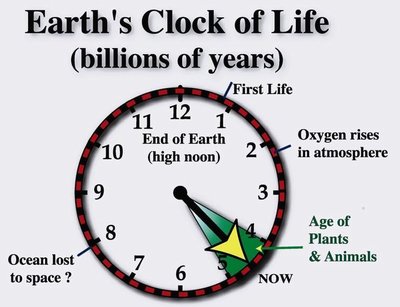January 13, 2003
‘The end of the world’ has already begun, UW scientists say
In its 4.5 billion years, Earth has evolved from its hot, violent birth to the celebrated watery blue planet that stands out in pictures from space. But in a new book, two noted University of Washington astrobiologists say the planet already has begun the long process of devolving into a burned-out cinder, eventually to be swallowed by the sun.
By their reckoning, Earth’s “day in the sun” has reached 4:30 a.m., corresponding to its 4.5 billion-year age. By 5 a.m., the 1 billion-year reign of animals and plants will come to an end. At 8 a.m. the oceans will vaporize. At noon – after 12 billion years – the ever-expanding sun, transformed into a red giant, will engulf the planet, melting away any evidence it ever existed and sending molecules and atoms that once were Earth floating off into space.
“The disappearance of our planet is still 7.5 billion years away, but people really should consider the fate of our world and have a realistic understanding of where we are going,” said UW astrophysicist Donald Brownlee. “We live in a fabulous place at a fabulous time. It’s a healthy thing for people to realize what a treasure this is in space and time, and fully appreciate and protect their environment as much as possible.”
In “The Life and Death of Planet Earth,” Brownlee and UW paleontologist Peter Ward use current scientific understanding of planets and stars, as well as the parameters of life, to provide a glimpse of the second half of life on Earth and what comes after.
The book, a sort of biography of our planet, is being published today by Times Books, a division of Henry Holt and Co. It is a sequel to Ward and Brownlee’s best-selling and much-discussed book “Rare Earth,” in which they put forth the hypothesis that simple life is relatively common in the universe but complex, Earth-like life is exceedingly rare.
“The Life and Death of Planet Earth” explains how the myriad life on Earth today was preceded by a long period of microbial dominance, and the authors contend that complex life eventually will disappear and be succeeded again by a period of only microbial life. They say that higher life will be removed much as it came into being, ecosystem by ecosystem. Aspects of the planet’s past, such as numbingly cold ice ages, will be relived in the period of devolution.
“If we do begin to slide into the next glacial cycle, there probably are grand, planetary-scale engineering projects that might stop or lessen the effects,” Ward said.
“The big unknowns are whether we can afford to do such projects and would we really know what to do. If the planet was cooling, we could, in principle, begin painting the surface black to collect more heat. Could we afford it? And what would be the many possible ramifications of a planet suddenly covered in black paint? Any planetary remediation project would always run the risk of making things worse.”
Eventually, though, scorching heat will drive land creatures to the sea for respite. Those that can adapt will survive for a time, but eventually the oceans will warm too much for the complex life forms to continue.
“The last life may look much like the first life – a single-celled bacterium, survivor and descendant of all that came before,” the authors write. Finally, even the surviving microbes “will be seared out of existence.”
The prospects of humans surviving by moving to some other habitable planet or moon aren’t good, Brownlee and Ward contend, because even if such a place were found, getting there would be a huge obstacle. Various probes sent into space could survive Earth’s demise, and just a few grams of material could arguably carry a DNA sample from every human, they say, but it’s not likely the human species itself will survive. Long before the planet’s final end, life will become quite challenging, and finally impossible, for humans.
As the sun gets hotter and grows in size, it will envelop Mercury and Venus. It is possible it will stop just short of Earth, the authors say, but the conditions still would make this a most-inhospitable planet. More likely, though, the sun will consume Earth as well, severing all the chemical bonds between molecules and sending its individual atoms out into space, perhaps eventually to form new planets. That would leave Mars as the nearest planet to the sun, and on Mars the fading sun’s glow would be like that of Earth’s moon.
That end is still some 7.5 billion years distant, but by then Earth will have faced a variety of “ends” along the way, the authors say. The last dinosaur perished long ago. Still to come are the last elephant, the last tree, the last flower, the last glacier, the last snowflake, the last ocean, the last life.
“The Life and Death of Planet Earth” is like its predecessor, “Rare Earth,” in that the authors collected and distilled some of the latest scientific ideas about the Earth’s place in the universe, Brownlee said. He hopes the new book, like “Rare Earth,” will spark widespread discussion, and give people a fundamental and realistic view of the past and future of their planet.
“It’s a healthy thing to think of the place of Earth among the other planets, and its place in the sun. The sun gave life and ultimately it will bring death.”
###
For more information, contact Brownlee at (206) 543-8575 or brownlee@bluemoon.astro.washington.edu or Ward at (206) 543-2962 or argo@u.washington.edu

